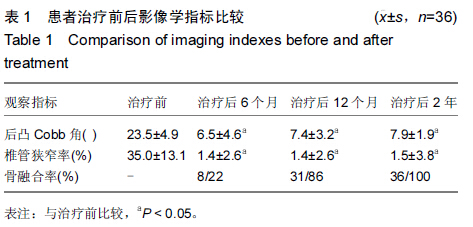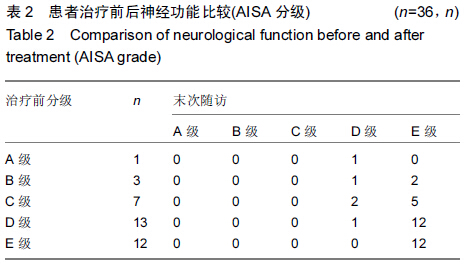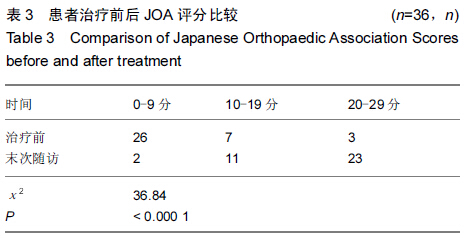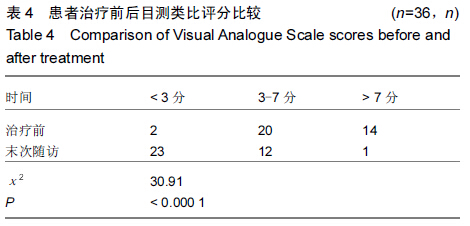中国组织工程研究 ›› 2015, Vol. 19 ›› Issue (44): 7120-7124.doi: 10.3969/j.issn.2095-4344.2015.44.013
• 脊柱植入物 spinal implant • 上一篇 下一篇
单节段胸腰椎结核植骨融合内固定:有效重建脊柱稳定性及矫正畸形
陈 涛,贾世青,刘昌生,赖英静,张 翔
- 玉林市中西医结合骨科医院,广西壮族自治区玉林市 537000
Bone graft fusion fixation for single-segment thoracic/lumbar spinal tuberculosis: effective reconstruction of spinal stabilization and deformity correction
Chen Tao, Jia Shi-qing, Liu Chang-sheng, Lai Ying-jing, Zhang Xiang
- Yulin Orthopedics Hospital of Integrated Traditional Chinese and Western Medicine, Yulin 537000, Guangxi Zhuang Autonomous Region, China
摘要:
背景:在彻底病灶清除的基础上,同期前路或分期行后路内固定已成为脊柱结核外科治疗的标准方案。虽然大量文献证实二者均取得良好的效果,但是也存在前路解剖结构复杂,创伤大,并发症相对较多,操作及内固定物置入困难等一系列缺点。 目的:观察后路经椎间隙病灶清除及椎间植骨融合内固定治疗后单节段胸腰椎结核患者脊柱稳定性及畸形矫正情况。 方法:回顾性分析2008年1月至2012年1月广西玉林市中西医结合骨科医院收治的行一期后路经椎间隙病灶清除植骨融合内固定治疗的单节段胸腰椎结核患者36例,病变节段T11/12节段2例,T12/L1节段4例,L3/4节段6例,L4/5节段22例,L5/S1节段2例;其中24例患者有不同程度的脊髓神经损伤表现。治疗后6,12,24个月对所有患者进行随访,观察植骨融合、后凸畸形矫正、脊髓功能恢复及并发症发生情况。 结果与结论:治疗后随访24-38个月。治疗后2年患者后凸Cobb角、椎管狭窄率较治疗前显著改善(P < 0.05)。末次随访患者腰椎背部疼痛症状均明显缓解(P < 0.05),椎间融合率为100%。治疗后随访无病灶残留及复发,无矫正丢失,无内固定松动、移位等并发症。提示对于单节段胸腰椎结核患者,后路经椎间隙病灶清除及椎间植骨融合内固定能够有效重建脊柱稳定性,矫正畸形,促进脊髓神经功能恢复。 中国组织工程研究杂志出版内容重点:人工关节;骨植入物;脊柱;骨折;内固定;数字化骨科;组织工程




